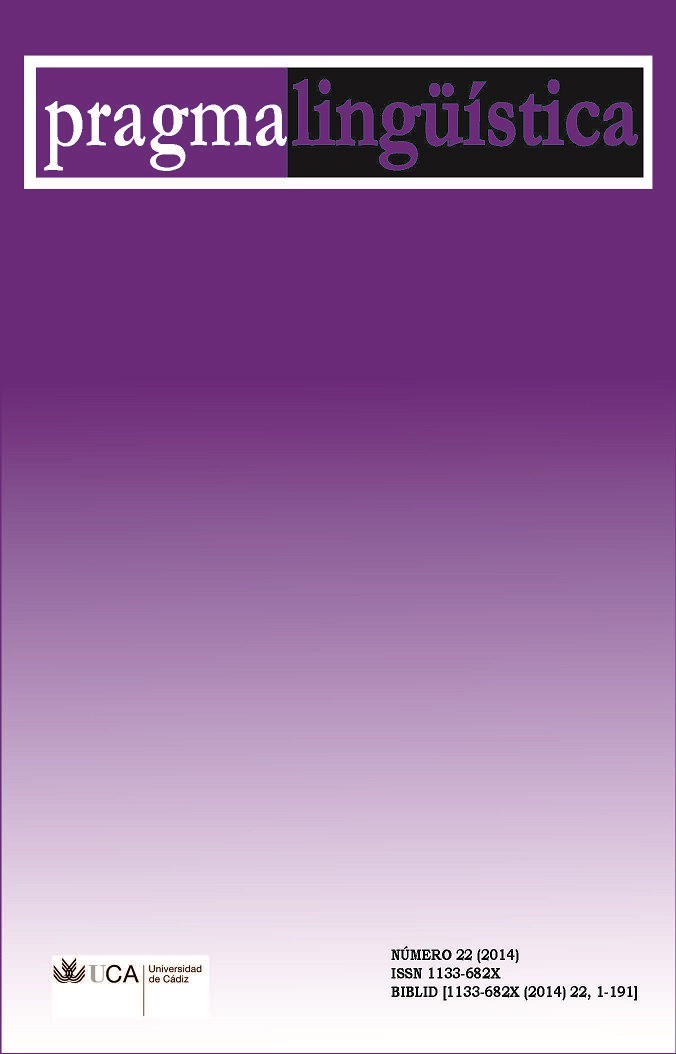¿Vale siempre una imagen más que mil palabras?

Archivos adicionales
DOI
https://doi.org/10.25267/Pragmalinguistica.2014.i22.06Información
Resumen
El presente estudio pretende comprobar la capacidad del ser humano para identificar emociones en fotografías, mediante el análisis de expresiones faciales. Para ello, empleamos imágenes de reclusos de una prisión española, que presentamos a 96 alumnos del Grado en Criminología y Seguridad de la Universidad de Cádiz. Los resultados demuestran que determinadas expresiones faciales de emoción son difícilmente interpretables si se analizan de forma aislada, es decir, sin combinarlas con otros elementos no verbales, el paralenguaje e informaciones de carácter pragmático, como el contexto y el conocimiento del otro.
Palabras clave
Descargas
Agencias de apoyo
Cómo citar
Licencia
Derechos de autor 2018 Pragmalingüística

Esta obra está bajo una licencia internacional Creative Commons Atribución-NoComercial-CompartirIgual 4.0.
Citas
ANTA, J. A. (2010): "Estudio de la conducta animal: Negociación y Comunicación Verbo-Corporal", VII Congreso de Criminología, Elche <http://www.grupodetecta.es/pdf/EstudiodelaConductaCriminalPonencia-Elche.pdf> (consulta: 15/10/2014).
ANTA, J. A. (2012): “Análisis Verbo Corporal (AVC): su utilidad en los secuestros”, Revista de Criminologia e Ciências Penitenciarias, 2 (2), <http://www.procrim.org/revist a/index.php/COPEN/article/vie w/61/128> (consulta: 15/10/2014).
CAMRAS, L. A. (1991): “A dynamical systems perspective on expressive development”, Strongman, K.T. (ed.): International Review of Studies on Emotion, New York: Wile, pp. 16-28.
CASAS GÓMEZ, M. y GARCÍA ANTUÑA, M. (2012): XII Jornadas de Lingüística, Cádiz, 30 de marzo y 1 de abril de 2009. Universidad de Cádiz: Servicio de Publicaciones.
EKMAN, P. (1979): “About Brows: Emotional and Conversational Signals”, Cranach, M., Foppa, K., Lepenies, W. y Ploog, D. (eds.): Human Ethology, Cambridge: Cambridge University Press, pp. 169-249.
EKMAN, P. (1988): “Lying and Nonverbal Behavior: Theoretical Issues and New Findings”, Journal of Nonverbal Behavior, 12 (3), pp. 163-175.
EKMAN, P., DAVIDSON, R. J. y FRIESEN, W. V. (1990): “The Duchenne Smile: Emotional Expression and Brain Physiology II”, Journal of Personality and Social Psychology, 58, pp. 342-353.
EKMAN, P. y FRIESEN, W. V. (1978): Facial Action Coding System: A Technique for the Measurement of Facial Movement, Palo Alto, California: Consulting Psychologists.
EKMAN, P., FRIESEN, W. V. y O'SULLIVAN, M. (1988): “Smiles when lying”, Journal of Personality and Social Psychology, 54, pp. 414-420.
EKMAN, P. y FRIESEN, W. V. (2003): Unmasking the Face: A Guide to Recognizing Emotions from Facial Clues, Cambridge: Malor Books.
FRANK M. G. y STENNETT J. (2001): “The forced-choice paradigm and the perception of facial expression of emotion”, Journal of Personality and Social Psychology, 80, pp. 75–85.
GOLEMAN, D. (2006): Emotional Intelligence: Why it can matter more than IQ, New York: Bantam Books.
KAPPAS, A. (2002): “What facial activity can and cannot tell us about emotions”, Katsikitis, M. (ed.): The Human Face: Measurement and Meaning, Dordrecht: Kluwer, pp. 215-234.
MEHRABIAN, A. (1971): “Nonverbal Communication”, Actas del Nebraska Symposium on Motivation, Nebraska: University of Nebraska Press, p. 140.
MEHRABIAN, A. (1981): Silent messages: implicit communication of emotions and attitudes, Belmont, California: Wadsworth.
RUSSELL, J. A. (1994): “Is There Universal Recognition of Emotion From Facial Expression? A Review of the Cross-Cultural Studies”, Psychological Bulletin, 115 (1), pp. 102-141.






